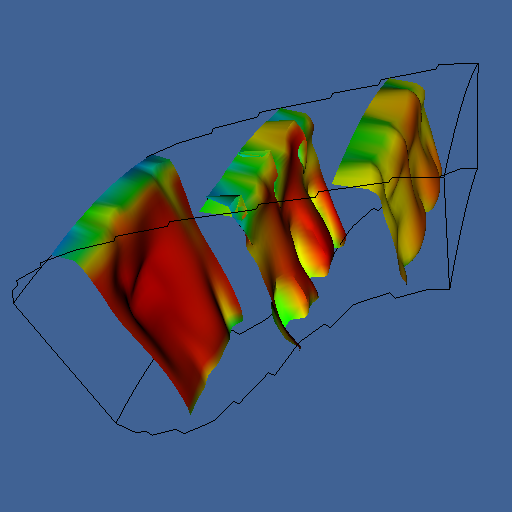VelocityProfile
vtk-examples/Cxx/VisualizationAlgorithms/VelocityProfile
Description¶
This example shows shows warped planes in a structured grid dataset. The planes are warped according to flow momentum. The relative back and forward flow are clearly visible in the deformation of the planes.
Info
See Figure 6-14b in Chapter 6 the VTK Textbook.
Other languages
See (Python)
Question
If you have a question about this example, please use the VTK Discourse Forum
Code¶
VelocityProfile.cxx
// Translated from velProf.tcl.
#include <vtkActor.h>
#include <vtkAppendPolyData.h>
#include <vtkCamera.h>
#include <vtkMultiBlockDataSet.h>
#include <vtkMultiBlockPLOT3DReader.h>
#include <vtkNamedColors.h>
#include <vtkNew.h>
#include <vtkPolyDataMapper.h>
#include <vtkPolyDataNormals.h>
#include <vtkProperty.h>
#include <vtkRenderWindow.h>
#include <vtkRenderWindowInteractor.h>
#include <vtkRenderer.h>
#include <vtkStructuredGrid.h>
#include <vtkStructuredGridGeometryFilter.h>
#include <vtkStructuredGridOutlineFilter.h>
#include <vtkWarpVector.h>
#include <array>
#include <iostream>
#include <string>
int main(int argc, char* argv[])
{
if (argc < 2)
{
std::cout << "Usage: " << argv[0] << " filename1 filename2" << std::endl;
std::cout << "where: filename1 is combxyz.bin and filename2 is combq.bin."
<< std::endl;
std::cout << "Produces figure 6-14(b) Flow momentum from the VTK Textbook."
<< std::endl;
return EXIT_FAILURE;
}
std::string fileName1 = argv[1];
std::string fileName2 = argv[2];
vtkNew<vtkNamedColors> colors;
std::array<unsigned char, 4> bkg{{65, 99, 149}};
colors->SetColor("BkgColor", bkg.data());
// Read a vtk file
//
vtkNew<vtkMultiBlockPLOT3DReader> pl3d;
pl3d->SetXYZFileName(fileName1.c_str());
pl3d->SetQFileName(fileName2.c_str());
pl3d->SetScalarFunctionNumber(100); // Density
pl3d->SetVectorFunctionNumber(202); // Momentum
pl3d->Update();
vtkStructuredGrid* pl3dOutput =
dynamic_cast<vtkStructuredGrid*>(pl3d->GetOutput()->GetBlock(0));
// What do we know about the data?
// Get the extent of the data: imin, imax, jmin, jmax, kmin, kmax
int extent[6] = {0, 0, 0, 0, 0, 0};
pl3dOutput->GetExtent(extent);
double scalarRange[2] = {0.0, 0.0};
pl3dOutput->GetScalarRange(scalarRange);
// Planes are specified using a imin, imax, jmin, jmax, kmin, kmax coordinate
// specification. Min and max i,j,k values are clamped to 0 and maximum value.
// See the variable named extent for the values.
//
vtkNew<vtkStructuredGridGeometryFilter> plane;
plane->SetInputData(pl3dOutput);
plane->SetExtent(10, 10, 1, extent[3], 1, extent[5]);
vtkNew<vtkStructuredGridGeometryFilter> plane2;
plane2->SetInputData(pl3dOutput);
plane2->SetExtent(30, 30, 1, extent[3], 1, extent[5]);
vtkNew<vtkStructuredGridGeometryFilter> plane3;
plane3->SetInputData(pl3dOutput);
plane3->SetExtent(45, 45, 1, extent[3], 1, extent[5]);
// We use an append filter because that way we can do the warping, etc. just
// using a single pipeline and actor.
//
vtkNew<vtkAppendPolyData> appendF;
appendF->AddInputConnection(plane->GetOutputPort());
appendF->AddInputConnection(plane2->GetOutputPort());
appendF->AddInputConnection(plane3->GetOutputPort());
// Warp
vtkNew<vtkWarpVector> warp;
warp->SetInputConnection(appendF->GetOutputPort());
warp->SetScaleFactor(0.005);
warp->Update();
vtkNew<vtkPolyDataNormals> normals;
normals->SetInputData(warp->GetPolyDataOutput());
normals->SetFeatureAngle(45);
vtkNew<vtkPolyDataMapper> planeMapper;
planeMapper->SetInputConnection(normals->GetOutputPort());
planeMapper->SetScalarRange(scalarRange);
vtkNew<vtkActor> planeActor;
planeActor->SetMapper(planeMapper);
// The outline provides context for the data and the planes.
vtkNew<vtkStructuredGridOutlineFilter> outline;
outline->SetInputData(pl3dOutput);
vtkNew<vtkPolyDataMapper> outlineMapper;
outlineMapper->SetInputConnection(outline->GetOutputPort());
vtkNew<vtkActor> outlineActor;
outlineActor->SetMapper(outlineMapper);
outlineActor->GetProperty()->SetColor(colors->GetColor3d("Black").GetData());
// Create the RenderWindow, Renderer and both Actors.
//
vtkNew<vtkRenderer> ren;
vtkNew<vtkRenderWindow> renWin;
renWin->AddRenderer(ren);
vtkNew<vtkRenderWindowInteractor> iren;
iren->SetRenderWindow(renWin);
// Add the actors to the renderer, set the background and size.
//
ren->AddActor(planeActor);
ren->AddActor(outlineActor);
ren->SetBackground(colors->GetColor3d("BkgColor").GetData());
renWin->SetSize(512, 512);
renWin->SetWindowName("VelocityProfile");
iren->Initialize();
renWin->Render();
ren->GetActiveCamera()->SetPosition(19.8562, -31.8912, 47.0755);
ren->GetActiveCamera()->SetFocalPoint(8.255, 0.147815, 29.7631);
ren->GetActiveCamera()->SetViewUp(-0.0333325, 0.465756, 0.884285);
ren->GetActiveCamera()->SetClippingRange(17.3078, 64.6375);
renWin->Render();
iren->Start();
return EXIT_SUCCESS;
}
CMakeLists.txt¶
cmake_minimum_required(VERSION 3.12 FATAL_ERROR)
project(VelocityProfile)
find_package(VTK COMPONENTS
CommonColor
CommonCore
CommonDataModel
FiltersCore
FiltersGeneral
FiltersGeometry
IOParallel
InteractionStyle
RenderingContextOpenGL2
RenderingCore
RenderingFreeType
RenderingGL2PSOpenGL2
RenderingOpenGL2
)
if (NOT VTK_FOUND)
message(FATAL_ERROR "VelocityProfile: Unable to find the VTK build folder.")
endif()
# Prevent a "command line is too long" failure in Windows.
set(CMAKE_NINJA_FORCE_RESPONSE_FILE "ON" CACHE BOOL "Force Ninja to use response files.")
add_executable(VelocityProfile MACOSX_BUNDLE VelocityProfile.cxx )
target_link_libraries(VelocityProfile PRIVATE ${VTK_LIBRARIES}
)
# vtk_module_autoinit is needed
vtk_module_autoinit(
TARGETS VelocityProfile
MODULES ${VTK_LIBRARIES}
)
Download and Build VelocityProfile¶
Click here to download VelocityProfile and its CMakeLists.txt file. Once the tarball VelocityProfile.tar has been downloaded and extracted,
cd VelocityProfile/build
If VTK is installed:
cmake ..
If VTK is not installed but compiled on your system, you will need to specify the path to your VTK build:
cmake -DVTK_DIR:PATH=/home/me/vtk_build ..
Build the project:
make
and run it:
./VelocityProfile
WINDOWS USERS
Be sure to add the VTK bin directory to your path. This will resolve the VTK dll's at run time.
